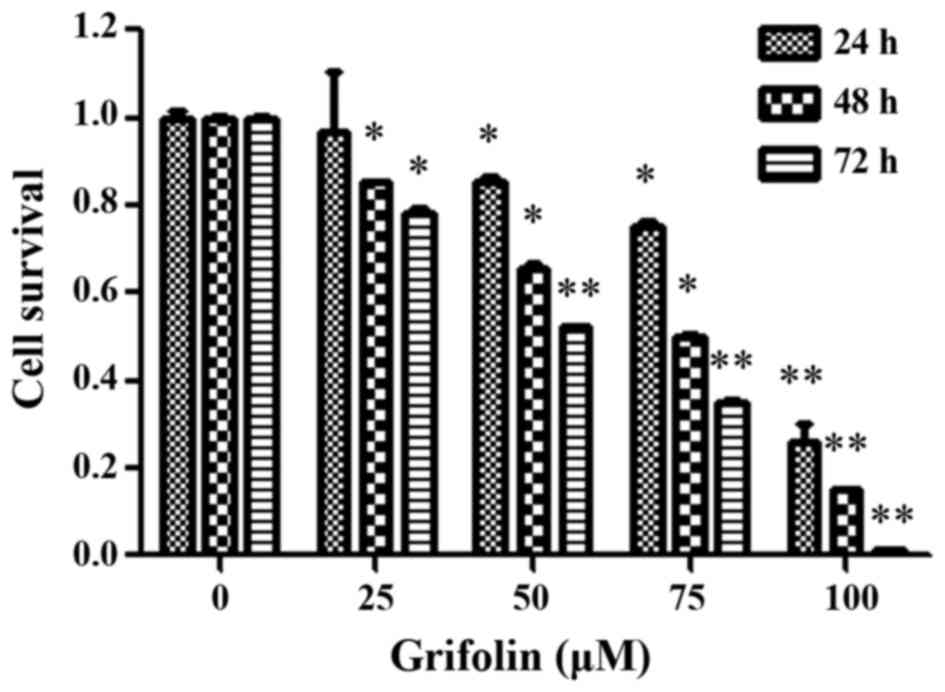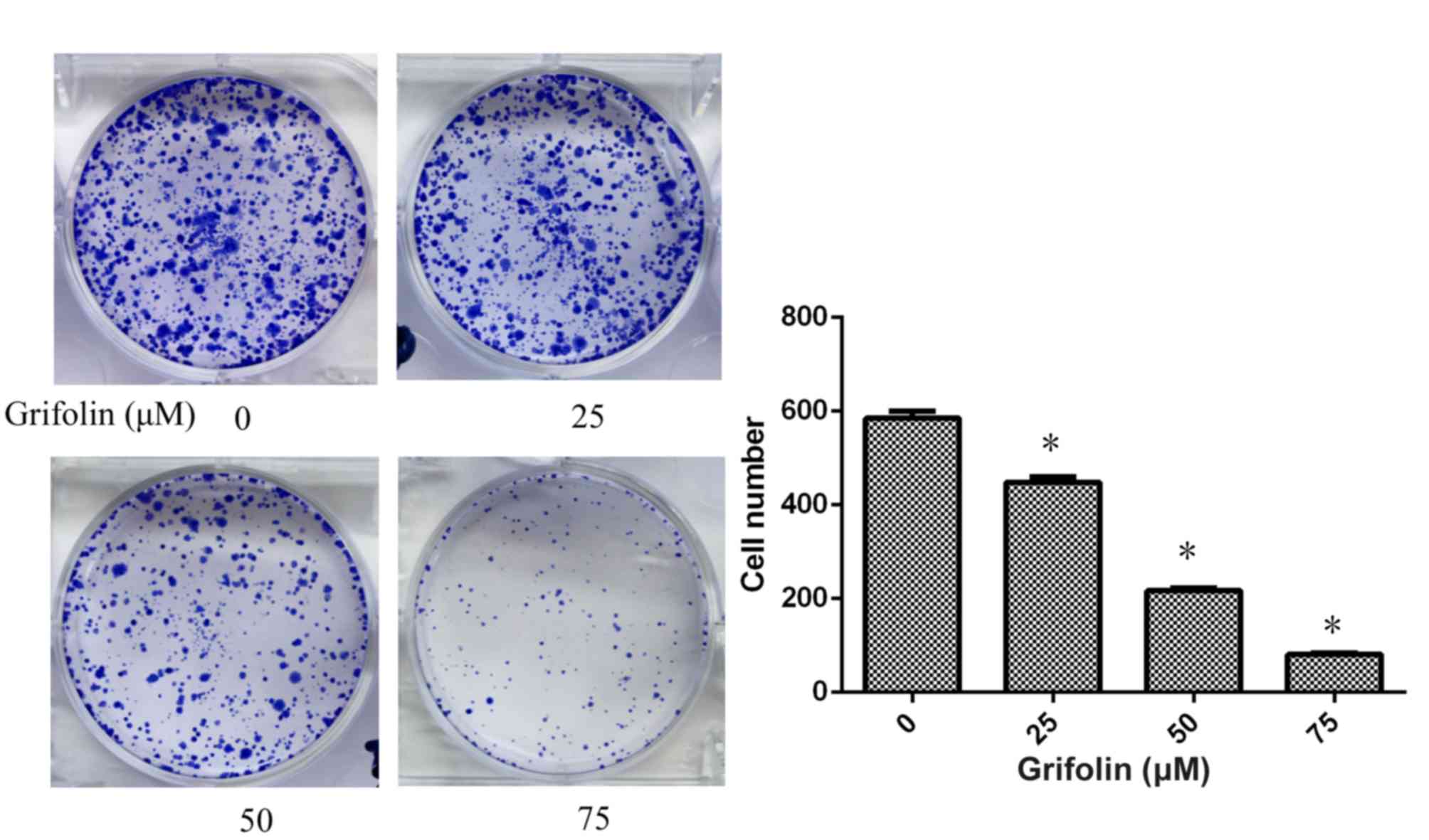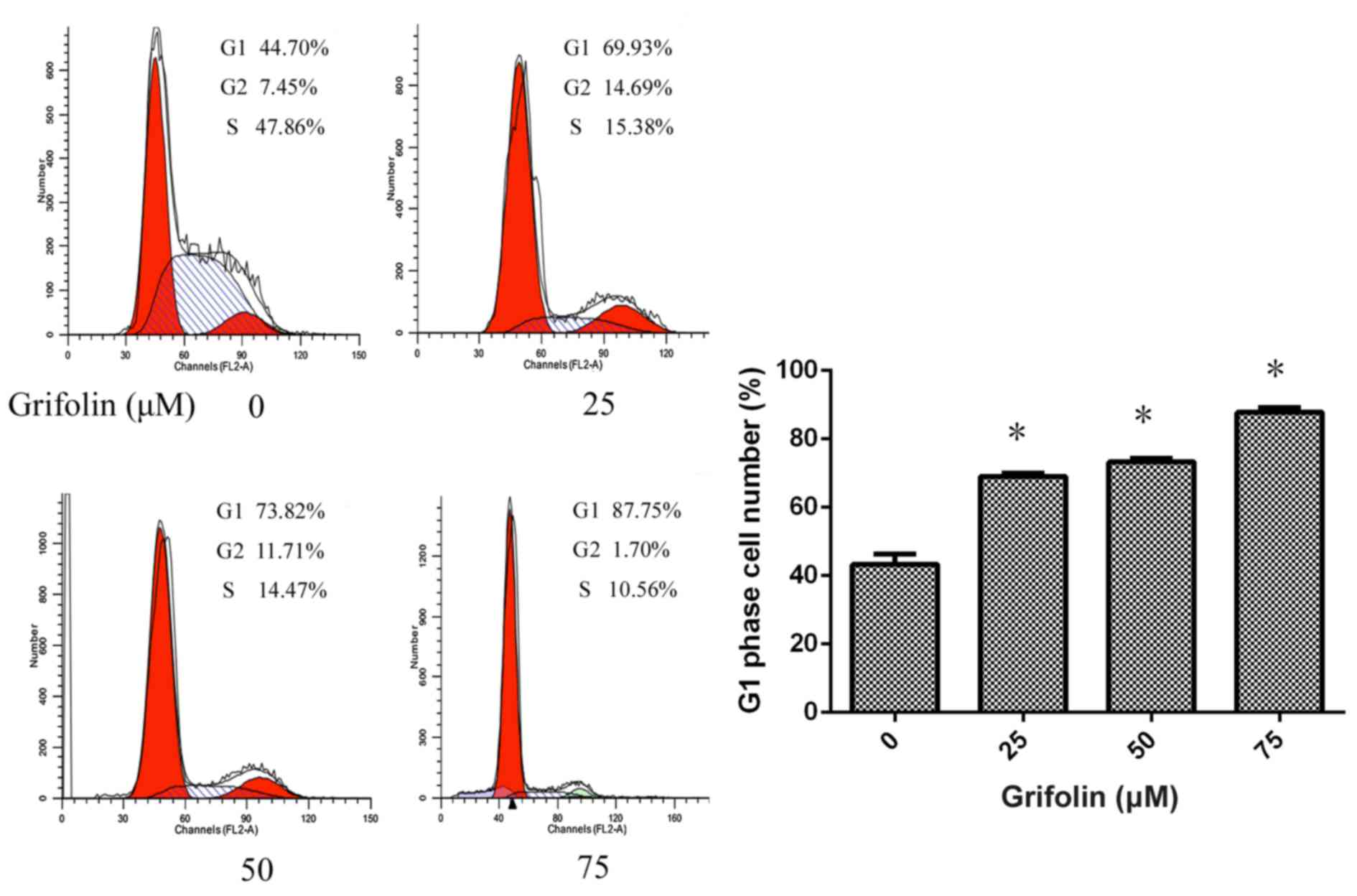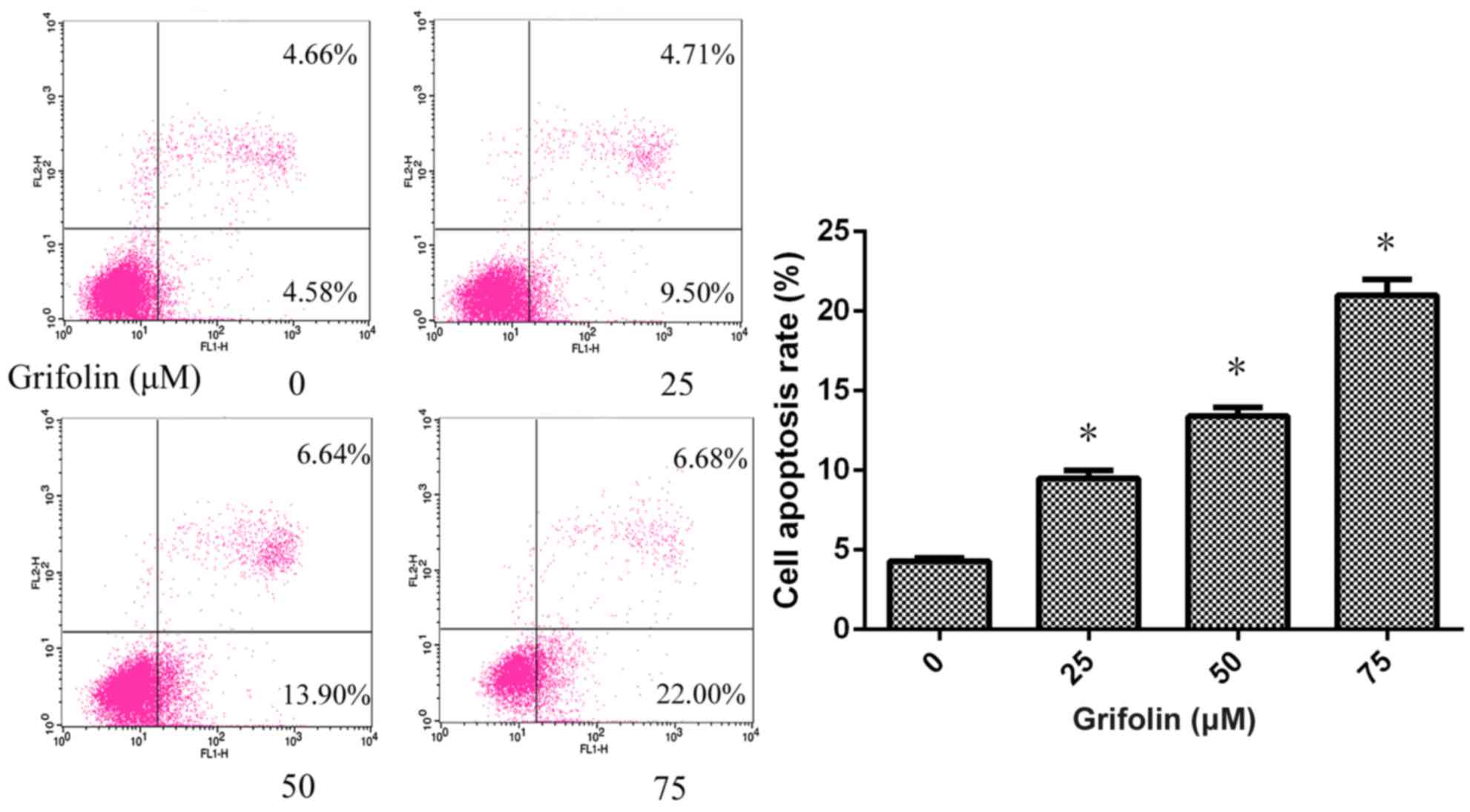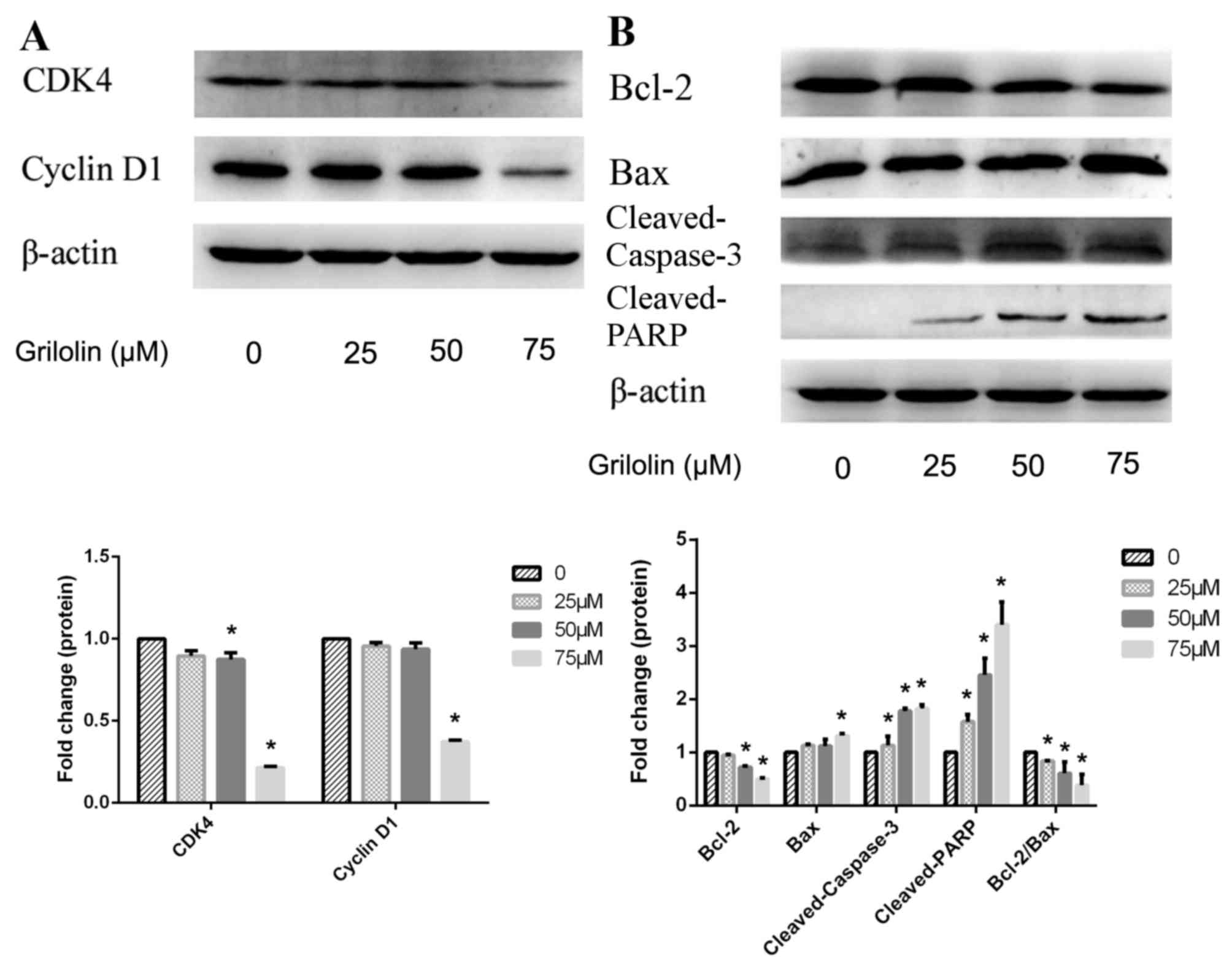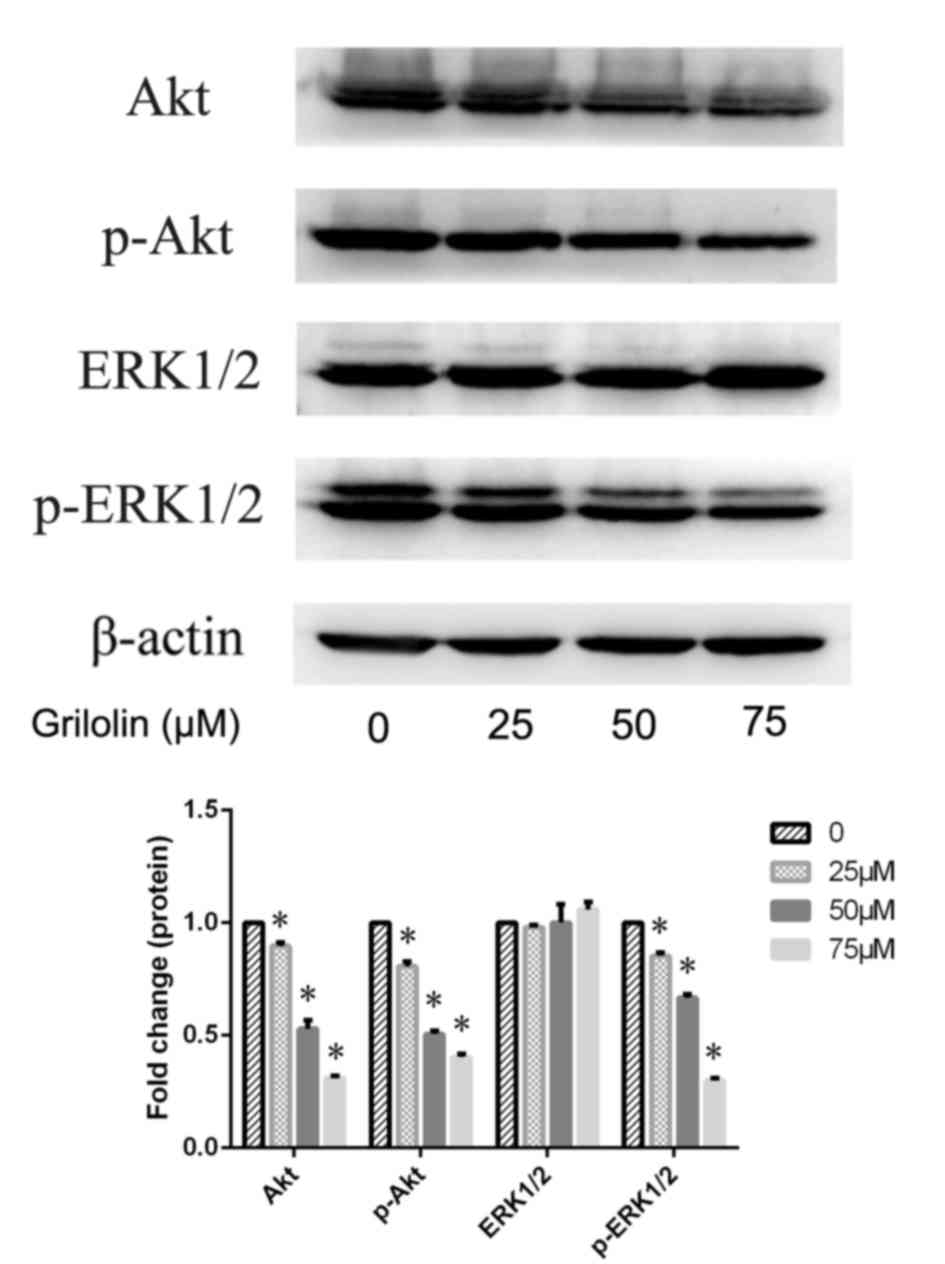Grifolin induces apoptosis and promotes cell cycle arrest in the A2780 human ovarian cancer cell line via inactivation of the ERK1/2 and Akt pathways
- Authors:
- Published online on: April 25, 2017 https://doi.org/10.3892/ol.2017.6092
- Pages: 4806-4812
-
Copyright: © Yan et al. This is an open access article distributed under the terms of Creative Commons Attribution License.
Abstract
Introduction
Ovarian cancer is a gynecological malignancy with one of the highest mortality rates worldwide (1). Even though the incidence of cervical cancer and endometrial cancer are higher at present (2), ovarian cancer ranks fifth as a cause of cancer-associated mortality among women (3,4). Ovarian cancer is not typically diagnosed at an early stage, with the majority of women already at advanced stages (International Federation of Gynecology and Obstetrics stage) when diagnosed, which presents a severe challenge for resection and recovery (5). Based on this situation, a combination of surgery and chemotherapy are the conventional methods of treatment. However, despite the efficacy of chemotherapy, its side effects are inevitable. Thus, a novel therapeutic agent against ovarian cancer is required.
At present, the use of natural agents for cancer prevention and therapy is attracting increased attention. Grifolin, which originates from the edible fruiting bodies of the mushroom AIbatrellus confluence, has been reported to possess antioxidant and antitumor activities (6). However, the effect of grifolin on ovarian cancer cells remains to be investigated. Therefore, the aim of the present study was to examine the effect of grifolin on the human ovarian cancer cell line, A2780, in vitro.
The present study revealed that grifolin effectively suppressed viability and induced apoptosis of human ovarian cancer A2780 cells. The present study also researched the exact targets and molecular mechanisms underlying grifolin-induced anticancer activity in A2780 cells, and revealed that inactivation of protein kinase B (Akt) and extracellular signal-related kinase (ERK1/2) is necessary for grifolin-induced cell cycle arrest and cell apoptosis. Grifolin may therefore be a promising anti-tumor agent for the treatment of ovarian cancer.
Materials and methods
Cell culture
The A2780 cell line was cultured in RPMI-1640 medium with 10% fetal bovine serum. Cells were maintained in a humidified incubator with 5% CO2 at 37°C. The cell culture media was obtained from HyClone (GE Healthcare Life Sciences, Logan, UT, USA), the fetal bovine serum was provided by Cell Signaling Technology, Inc., (Danvers, MA, USA).
Drugs and chemicals
Grifolin was provided by the Kunming Institute of Botany; Chinese Academy of Sciences (Kunming, China) with the following structure: 2-trans, trans-farnesyl-5-methylresorcinol (purity, >99%; high performance liquid chromatography analysis). Grifolin was prepared at a concentration of 100 mmol/l stock solution in dimethyl sulfoxide (DMSO) and stored under −20°C so that the final concentration of DMSO was <0.1% in all assays it was used in. DMSO was provided by (Shanghai Biyuntian Bio-Technology Company, Ltd., Shanghai, China).
Cell proliferation assay
The effect of grifolin on A2780 cell viability was evaluated by MTT assay. Cells were seeded at a density of 3,000–3,500 cells/well in 96-well plates, which permitted logarithmic growth during the 72 h assay, and cultured overnight at 37°C with 5% CO2. Adherent cells were subsequently exposed to grifolin at varying concentrations (0, 20, 40, 60, 80 and 100 µM) for 24, 48 and 72 h. The cells were then washed with PBS twice and incubated in 20 µl MTT (HyClone; GE Healthcare Life Sciences) for 4 h. The cell suspension was discarded and the cells were supplemented with 100 µl DMSO. At the MTT endpoint, an infinite M200PRO microplate reader (Bio-Rad Laboratories, Hercules, CA, USA) was used to measure cell viability at 490 or 550 nm absorbance. The cell viability trend and the half maximal inhibitory concentrations (IC50) were analyzed using SPSS Statistics 18.0 software (SPSS, Inc., Chicago, IL, USA). Finally, GraphPad Prism 5 software (GraphPad Software, Inc., La Jolla, CA, USA) was used to draw up the bar graph.
Clonogenic assay
A2780 cells (5×102) were seeded on 6-well plates and exposed to grifolin (0, 25, 50 or 75 µM) for 48 h with 5% CO2 at 37°C. The cells were then washed with PBS twice and RPMI-1640 culture medium was added into the plates for ~10 days. The cells were washed with PBS twice, fixed with 4% paraformaldehyde solution for ~15 min, and then stained with 1 ml 0.2% crystal violet (HK Jimei Biology Science and Technology Company, Ltd., Beijing, China) for 30 min. Finally, the numbers of clones were counted and analyzed by using the DP71 fluorescence microscope (Olympus Corporation, Tokyo, Japan) with ×200 magnification 400–600 cells per field of view assessed.
Flow cytometry assay
Flow cytometry was used to detect the cell cycle and apoptosis distribution. Cells (1×106) were treated with 0, 25, 50 or 75 µM grifolin for 24 h, collected and washed with ice-cold PBS twice, fixed in 75% ethanol overnight at 4°C and stained with 20 µl Rnase A (Cell Signaling Technology, Inc., Danvers, MA, USA) and 400 µl propidium iodide (PI) at room temperature for 30 min. Apoptosis analysis was also performed using annexin V-fluorescein isothiocyanate and PI, following the manufacturers protocol. The apoptosis kit used in flow cytometry assay was provided by the (#50T; Jiehui Biology Science and Biotechnology Company, Ltd., Beijing, China,). The number of cells was calculated by FACScan flow cytometry (Bio-Rad Laboratories). The data was analyzed by WinMDI v2.9 software (The Scripps Research Institute, San Diego, CA, USA).
Western blot analysis
A2780 cells at a density of 4×105 were seeded per well and were incubated with grifolin at concentrations of 0, 25, 50 and 75 uM for 24 h, then harvested and homogenized in 100 µl RIPA lysis buffer for ~30 min on ice. The cells were centrifuged for 15 min 4°C at the speed 15,000 × g. The protein samples (20 µg/lane) were separated on 10 or 12% SDS-PAGE, transferred to polyvinylidene difluoride membranes. Following blocking using 5% non-fat milk at room temperature for ~2 h, the membranes were incubated with primary antibodies against phosphorylated (p-) ERK1/2 (#4370; 1:1,000; Cell Signaling Technology, Inc.), ERK1/2 (#4060; 1:1,000; Cell Signaling Technology, Inc., MA, USA), p-Akt (#4691; 1:1,000; Cell Signaling Technology, Inc.), Akt (#4691; 1:1,000; Cell Signaling Technology, Inc.), cleaved-poly (ADP-ribose) polymerase (PARP; #5625; 1:1,000; Cell Signaling Technology, Inc.), BCL2 associated X, apoptosis regulator (Bax; #ab32503; 1:1,000; Abcam, Cambridge, UK), B cell lymphoma-2 (Bcl-2; #ab32124; 1:1,000; Abcam), cleaved-Caspase-3 (#ab2302; 1:1,000; Abcam), CyclinD1 (#2922; 1:1000; Cell Signaling Technology, Inc.), cyclin dependent kinase 4 (CDK4; #12790; 1:1,000; Cell Signaling Technology, Inc.) and β-actin (#8457; 1:10,000; Cell Signaling Technology, Inc.) at 4°C overnight. The blots were washed with TBST (1,000 ml TBST with 1 ml Tween-20) three times and incubated with respective secondary antibodies (Goat anti-rabbit IgG Alexa Fluor® 488; #ab150077; 1:10,000; Cell Signaling Technology, Inc.) at 4°C for 1–2 h. Following three washes in TBST, the ImageQuant LAS 4000 (Immobilon®; EMD Millipore, Billerica, MA, USA) was used to visualize the blots and the expression levels of the proteins were analyzed using the NIH Image J system 1.48v (National Institutes of Health, Bethesda, MD, USA). Statistical significance was calculated using SPSS 18.0 software (SPSS, Inc.) and the histograms were obtained using the Graph Pad system v5.0 (GraphPad Software, Inc.).
Statistical analysis
A student t-test and one-way analysis of variance was used to compare the means of different treatments, using SPSS 18.0 software (SPSS, Inc.). Date were expressed as the mean ± standard deviation, and P<0.05 was considered to indicate a statistically significant difference.
Results
Grifolin decreases cell viability in the human ovarian cancer cell line, A2780
The effect of grifolin on human ovarian cancer cell viability was analyzed using the MTT assay, clonogenic assay and flow cytometry. For this purpose, A2780 cells were incubated with grifolin (0, 25, 50, 75 and 100 µM) for 24, 48 and 72 h. The results revealed a significant decrease in the viability of A2780 cells, in a dose-dependent and time-dependent manner (P<0.05; Fig. 1). A2780 cells (5×102) were seeded on 6-well culture plates and treated with grifolin at concentrations of 0, 25, 50 and 75 µM. The results revealed that grifolin suppressed A2780 cell viability significantly (P<0.05; Fig. 2). Flow cytometry analysis was used to determine the stage that A2780 cells were suspended in, and grifolin was demonstrated to result in a cell cycle block at the G1 phase (P<0.05; Fig. 3).
Grifolin induced apoptosis in human A2780 ovarian cancer cells
Flow cytometry analysis was used to determine whether grifolin induced apoptosis in A2780 cells. Grifolin-treated A2780 cells were stained with annexin V-FITC and PI following treatment with grifolin (0, 25, 50, and 75 uM) for 24 h. Grifolin-treated A2780 cells were demonstrated to have undergone apoptosis in a dose-dependent manner, and these results corroborated the data from the MTT assay (P<0.05; Fig. 4).
Grifolin treatment affected the expression of cell cycle proteins and apoptosis family proteins
Next, the protein expressions of cell cycle proteins (cyclinD1 and CDK4) and apoptosis associated proteins (Bcl-2, Bax, cleaved-caspase-3 and cleaved-PARP) were analyzed to further assess the potential mechanisms underlying grifolin-induced apoptosis and inhibition of cell viability. Western blot analysis was used to assess the expression of cyclinD1 and CDK4, which were visibly decreased in cells treated with grifolin compared with the control (P<0.05; Fig. 5) Western blot analysis also revealed that Bcl-2 expression was visibly decreased, while the expression of Bax was visibly increased compared with untreated cells (Fig. 5). In addition, the expression of cleaved caspase-3 and cleaved-PARP was significantly increased compared with untreated cells (P<0.05; Fig. 5). These results demonstrated that grifolin treatment downregulated cell cycle proteins and upregulated the Bax/Bcl-2 ratio, cleaved caspase-3 and cleaved-PARP expression.
Grifolin inactivated Akt and ERK1/2 in A2780 cells
Activation of phosphatidylinositol 3-kinase (PI3K)/Akt and mitogen-activated protein kinase (MAPK) pathways has been demonstrated to be associated with the expression of apoptosis-associated proteins. Thus, western blotting was used to evaluate the expression of Akt and ERK1/2 in grifolin-treated A2780 cells, and to determine whether the Akt and ERK1/2 pathways are potential signaling mechanisms underlying grifolin-induced apoptosis. The expression levels of p-Akt and p-ERK1/2 were significantly decreased in a dose-dependent manner in grifolin-treated cells compared with the untreated control (P<0.05; Fig. 6). These results suggested that inactivation of Akt and ERK1/2 may be the key mechanism underlying grifolin-induced apoptosis.
Discussion
At present, there has been growing interest in the function of grifolin, in particular concerning its anticancer effects. Grifolin, a secondary metabolite product isolated from the mushroom A. confluence, exhibits anti-cancer and therapeutic properties. Multiple studies have revealed that grifolin inhibits cell growth in certain types of cancer (7,8). Grifolin has been demonstrated to induce cell-cycle arrest via the ERK1/2 pathway in human nasopharyngeal carcinoma cells (7) and to induce apoptosis through inhibition of the Akt pathway in human osteosarcoma cells (8). However, there is little research concerning the effect of grifolin on ovarian cancer cells to date. In the present study, A2780 ovarian cancer cells were treated with different concentrations of grifolin in order to elucidate the underlying signaling pathways and molecular mechanisms. The results revealed that grifolin triggered apoptosis and cell cycle arrest in a dose-and time-dependent fashion, and decreased the phosphorylation of Akt and ERK1/2 in A2780 ovarian cancer cells in vitro. The results indicated that grifolin may inhibit cell viability and induce apoptosis in human ovarian cancer cells via two pathways; the Akt and the ERK1/2 pathways.
Multiple studies have demonstrated that mammalian cell cycle progression is closely associated with cyclins and CDKs (9,10). Uncontrolled cell cycle progression is an identified characteristic of multiple types of cancer (9). A previous study demonstrated that grifolin significantly induced cell cycle arrest at the G1 phase in human nasopharyngeal carcinoma cell line CNE1 (7). Verifying this finding, the data obtained from flow cytometry analysis in the present study indicated that grifolin induced G1 cell cycle arrest in A2780 cells. Thus, attention was directed towards the underlying molecular mechanisms of cell cycle arrest in A2780 cells treated with grifolin. CyclinD1 has been demonstrated to be a mitogenic sensor that amplifies extracellular growth signals (10). Overexpression of different cyclins and CDKs provides cancer cells with the advantage of rapid cyclical growth (11). The cyclinD1/CDK4 complex promotes DNA synthesis and cell cycle progression from the G1 to the S phase (12). In accordance, downregulation of cyclinD1 and CDK4 may be a promising treatment for cancer. As expected, the present study demonstrated that grifolin treatment resulted in a dose-dependent decrease in the expression of cyclinD1 and CDK4. Thus, the data obtained by flow cytometry were further verified by the results of the western blot assay.
Members of the caspase family participate in physiological activity through pathways including the mitochondrial and death receptor pathway (13). Activation of distinct caspase cascades is known to be involved in activating and cleaving certain proteins that are crucial to cellular activities and functions (14). In general, caspase-3 is recognized as the key apoptotic mediator (15). A previous study demonstrated that one of the caspase family substrates, PARP, which possesses a wide range of physiological functions, the most prominent of which is recovering damaged DNA (16), is cleaved by caspase-3 into two fragments (24 and 89 kDa, respectively), with different functions. The 24 kDa PARP fragment weakens DNA repair by inhibiting DNA repair enzymes, thereby contributing to cell death (17). In the present study, treatment with grifolin resulted in the upregulation of cleaved caspase-3 and cleaved PARP in A2780 cells, further demonstrating that the anti-cancer activity is regulated by caspase-dependent cell apoptosis. As well as investigating the activation of caspase-3 and PARP, the expression of Bcl-2 family members, which have been identified as upstream regulators of the caspase cascade (18,19), were assessed. It is possible to subdivide the Bcl-2 protein family into pro-apoptotic components, including Bax and Bcl-2 associated agonist of cell death, and anti-apoptotic components, including Bcl-2 and B cell lymphoma-extra large (20). The present study demonstrated that Bcl-2 protein levels were decreased, as demonstrated by western blotting, while the expression of Bax was slightly altered. However, the Bcl-2/Bax ratio was significantly lowered. It has been confirmed that the Bcl-2/Bax ratio is crucial for regulating cellular apoptosis (21). Alteration of this ratio may increase the rate of apoptosis of A2780 cells exposed to grifolin.
Cellular signaling pathways are known to include diverse proteins, and are complex communication networks that control basic biological functions. Several cellular signaling pathways are known to regulate cell proliferation and apoptosis, including nuclear factor-κB, PI3K/Akt, MAPK and p53 signaling pathways. The aim of the present study was to define the pathways participating in grifolin-induced anti-cancer effects. The majority of previous studies have confirmed that activation of the ERK1/2 or Akt pathway is associated with the anticancer effect of grifolin (7,8) Nevertheless, to date, knowledge concerning the effect of grifolin in human ovarian cancer cells and underlying mechanisms is lacking. Thus, the present study aimed to explore the signaling pathways underlying the pro-apoptotic action of grifolin on A2780 cells. Accumulating evidence indicates that the Akt pathway is a complex signal transduction pathway participating in rigorous regulation of cell differentiation, proliferation and apoptosis (22,23). Akt phosphorylation promotes cell survival and proliferation, and activation of Akt may contribute to tumorigenesis and tumor progression (24). The results of the present study demonstrated that the activation of Akt in A2780 cells was decreased by grifolin in a concentration-dependent manner. MAPK members are classified into three major subfamilies: p38MAP, ERK1/2 and c-Jun N-terminal Kinase, and phosphorylation of ERK1/2 lead to progressing cell cycle and inhibiting cell apoptosis (25). Furthermore, in the present study, the phosphorylation level of ERK1/2 was evaluated and demonstrated to be markedly decreased by grifolin. Hence, it is possible to conclude that grifolin induced apoptosis and arrested cell cycle progression at the G1 phase by downregulating phosphorylated ERK1/2 and Akt levels, which resulted in altered expression of caspase-3, Bax, CDK4 and cyclinD1.
In conclusion, grifolin, which has been known for several decades to demonstrate various pharmacological and physiological effects and to inhibit the growth of multiple cancer cell lines, also had an anticancer effect against the human ovarian cancer cell line, A2780. To the best of our knowledge, the present study is the first report to explore the activity of grifolin on human ovarian cancer cells. The results demonstrated that inactivation of Akt and ERK1/2 was the mechanism underlying grifolin-induced cell cycle arrest and cell apoptosis. Grifolin may therefore be a promising antitumor agent for the treatment of ovarian cancer.
Acknowledgements
The present study was funded by the National Natural Science Foundation of China (grant nos. 81072121, 81372808 and 81173614), the Science and Technology Development Planning of Shandong (grant nos. 2012G0021823 and 2011GSF12122) and the Science and Technology Development Planning of Jinan (grant no. 201303035).
References
|
Gloss BS and Samimi G: Epigenetic biomarkers in epithelial ovarian cancer. Cancer Lett. 342:257–263. 2014. View Article : Google Scholar : PubMed/NCBI | |
|
Chen C, Chang YC, Lan MS and Breslin M: Leptin stimulates ovarian cancer cell growth and inhibits apoptosis by increasing cyclin D1 and Mcl-1 expression via the activation of the MEK/ERK1/2 and PI3K/Akt signaling pathways. Int J Oncol. 42:1113–1119. 2013.PubMed/NCBI | |
|
Siegel R, Naishadham D and Jemal A: Cancer statistics, 2012. CA Cancer J Clin. 62:10–29. 2012. View Article : Google Scholar : PubMed/NCBI | |
|
Siegel R, Naishadham D and Jemal A: Cancer statistics, 2013. CA Cancer J Clin. 63:11–30. 2013. View Article : Google Scholar : PubMed/NCBI | |
|
Jayson GC, Kohn EC, Kitchener HC and Ledermann JA: Ovarian cancer. Lancet. 384:1376–1388. 2014. View Article : Google Scholar : PubMed/NCBI | |
|
Luo X, Yu X, Liu S, Deng Q, Liu X, Peng S, Li H, Liu J and Cao Y: The role of targeting kinase activity by natural products in cancer chemoprevention and chemotherapy (review). Oncol Rep. 34:547–554. 2015.PubMed/NCBI | |
|
Ye M, Luo X, Li L, Shi Y, Tan M, Weng X, Li W, Liu J and Cao Y: Grifolin, a potential antitumor natural product from the mushroom Albatrellus confluens, induces cell-cycle arrest in G1 phase via the ERK1/2 pathway. Cancer Lett. 258:199–207. 2007. View Article : Google Scholar : PubMed/NCBI | |
|
Jin S, Pang RP, Shen JN, Huang G, Wang J and Zhou JG: Grifolin induces apoptosis via inhibition of PI3K/AKT signalling pathway in human osteosarcoma cells. Apoptosis. 12:1317–1326. 2007. View Article : Google Scholar : PubMed/NCBI | |
|
Hanahan D and Weinberg RA: Hallmarks of cancer: The next generation. Cell. 144:646–674. 2011. View Article : Google Scholar : PubMed/NCBI | |
|
Hilakivi-Clarke L, Wang C, Kalil M, Riggins R and Pestell RG: Nutritional modulation of the cell cycle and breast cancer. Endocr Relat Cancer. 11:603–622. 2004. View Article : Google Scholar : PubMed/NCBI | |
|
Hall M and Peters G: Genetic alterations of cyclins, cyclin-dependent kinases, and Cdk inhibitors in human cancer. Adv Cancer Res. 68:67–108. 1996. View Article : Google Scholar : PubMed/NCBI | |
|
Kaukoniemi KM, Rauhala HE, Scaravilli M, Latonen L, Annala M, Vessella RL, Nykter M, Tammela TL and Visakorpi T: Epigenetically altered miR-193b targets cyclin D1 in prostate cancer. Cancer Med. 4:1417–1425. 2015. View Article : Google Scholar : PubMed/NCBI | |
|
Denault JB and Boatright K: Apoptosis in biochemistry and structural biology. 3–8 February 2004, Keystone, CO, USA. IDrugs. 7:315–317. 2004.PubMed/NCBI | |
|
Gupta S, Kass GE, Szegezdi E and Joseph B: The mitochondrial death pathway: A promising therapeutic target in diseases. J Cell Mol Med. 13:1004–1033. 2009. View Article : Google Scholar : PubMed/NCBI | |
|
Lakhani SA, Masud A, Kuida K, Porter GA Jr, Booth CJ, Mehal WZ, Inayat I and Flavell RA: Caspases 3 and 7: Key mediators of mitochondrial events of apoptosis. Science. 311:847–851. 2006. View Article : Google Scholar : PubMed/NCBI | |
|
Langelier MF and Pascal JM: PARP-1 mechanism for coupling DNA damage detection to poly(ADP-ribose) synthesis. Curr Opin Struct Biol. 23:134–143. 2013. View Article : Google Scholar : PubMed/NCBI | |
|
Sukhanova MV, Khodyreva SN and Lavrik OI: Influence of poly(ADP-ribose) polymerase-1 and its apoptotic 24-kD fragment on repair of DNA duplexes in bovine testis nuclear extract. Biochemistry (Mosc). 71:736–748. 2006. View Article : Google Scholar : PubMed/NCBI | |
|
Monian P and Jiang X: Clearing the final hurdles to mitochondrial apoptosis: Regulation post cytochrome C release. Exp Oncol. 34:185–191. 2012.PubMed/NCBI | |
|
Martinou JC and Youle RJ: Mitochondria in apoptosis: Bcl-2 family members and mitochondrial dynamics. Dev Cell. 21:92–101. 2011. View Article : Google Scholar : PubMed/NCBI | |
|
Cotter TG: Apoptosis and cancer: The genesis of a research field. Nat Rev Cancer. 9:501–507. 2009. View Article : Google Scholar : PubMed/NCBI | |
|
Antonsson B: Bax and other pro-apoptotic Bcl-2 family ‘killer-proteins’ and their victim the mitochondrion. Cell Tissue Res. 306:347–361. 2001. View Article : Google Scholar : PubMed/NCBI | |
|
Blanco-Aparicio C, Renner O, Leal JF and Carnero A: PTEN, more than the AKT pathway. Carcinogenesis. 28:1379–1386. 2007. View Article : Google Scholar : PubMed/NCBI | |
|
Fingar DC, Salama S, Tsou C, Harlow E and Blenis J: Mammalian cell size is controlled by mTOR and its downstream targets S6K1 and 4EBP1/elF4E. Genes Dev. 16:1472–1487. 2002. View Article : Google Scholar : PubMed/NCBI | |
|
Serrano ML, Sánchez-Gómez M, Bravo MM, Yakar S and LeRoith D: Differential expression of IGF-I and insulin receptor isoforms in HPV positive and negative human cervical cancer cell lines. Horm Metab Res. 40:661–667. 2008. View Article : Google Scholar : PubMed/NCBI | |
|
Diab S, Kumarasiri M, Yu M, Teo T, Proud C, Milne R and Wang S: MAP kinase-interacting kinases-emerging targets against cancer. Chem Biol. 21:441–452. 2014. View Article : Google Scholar : PubMed/NCBI |



